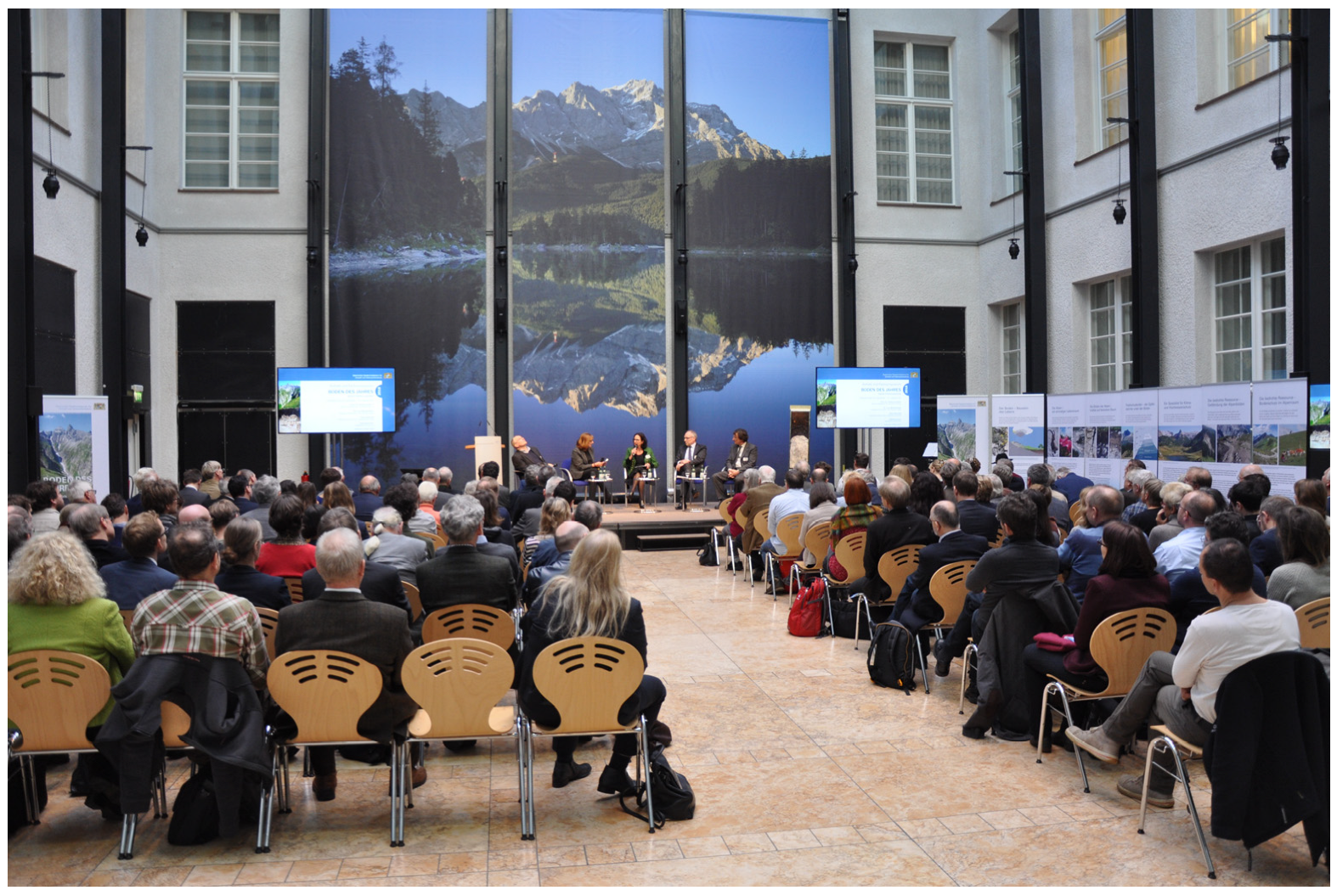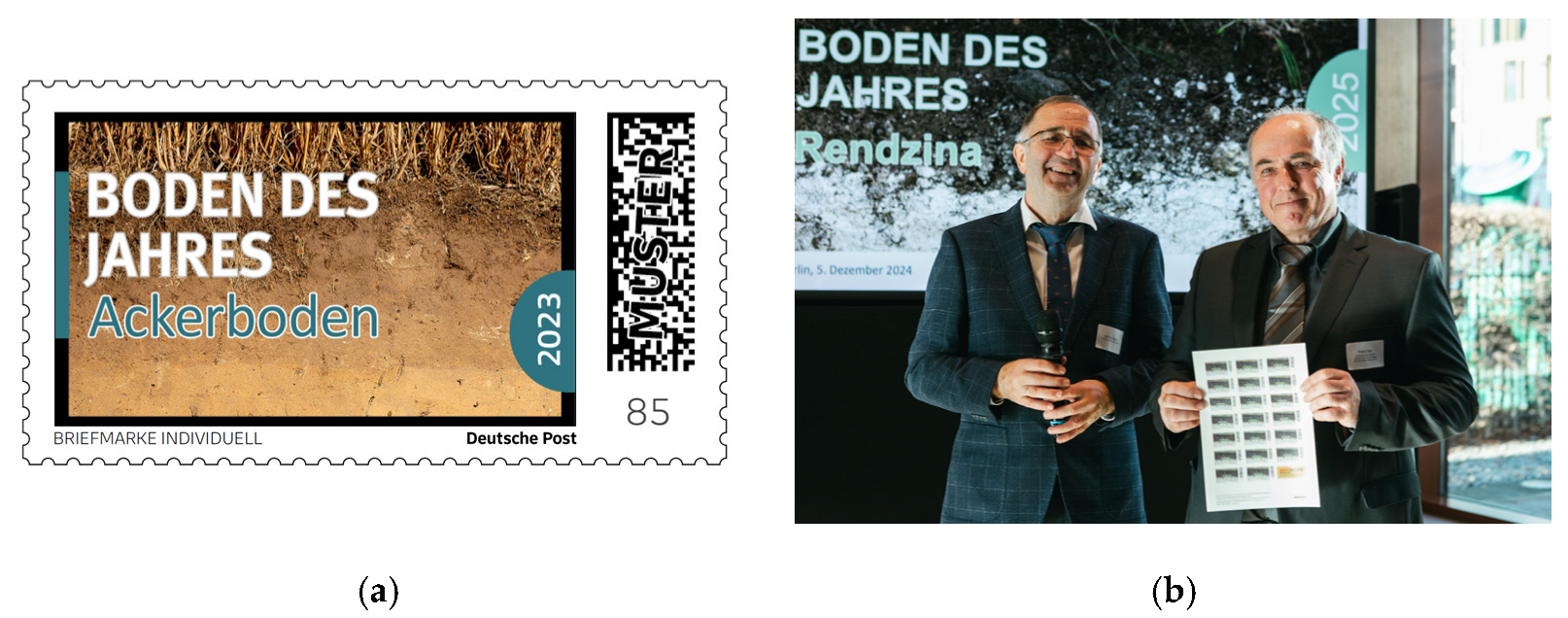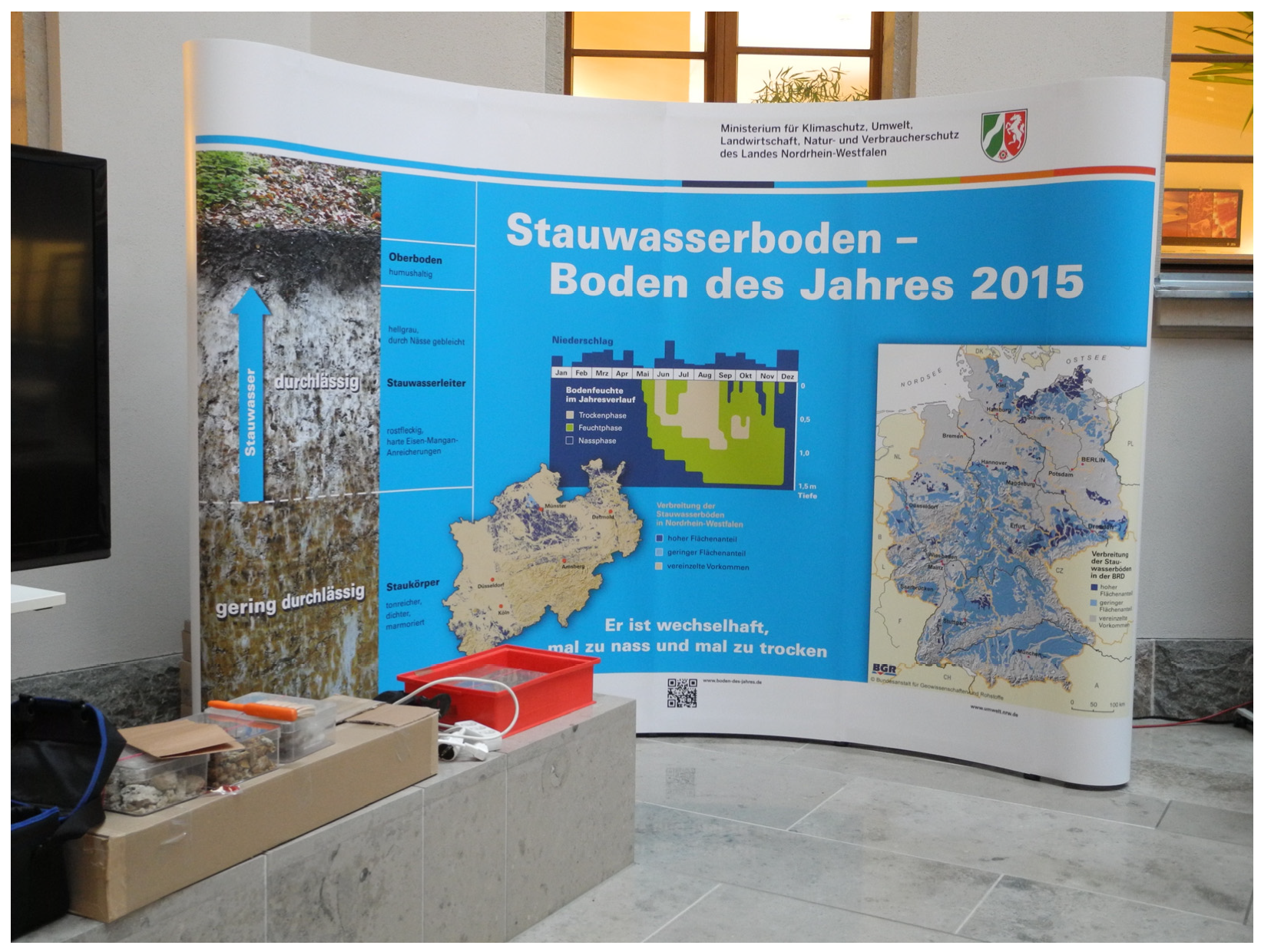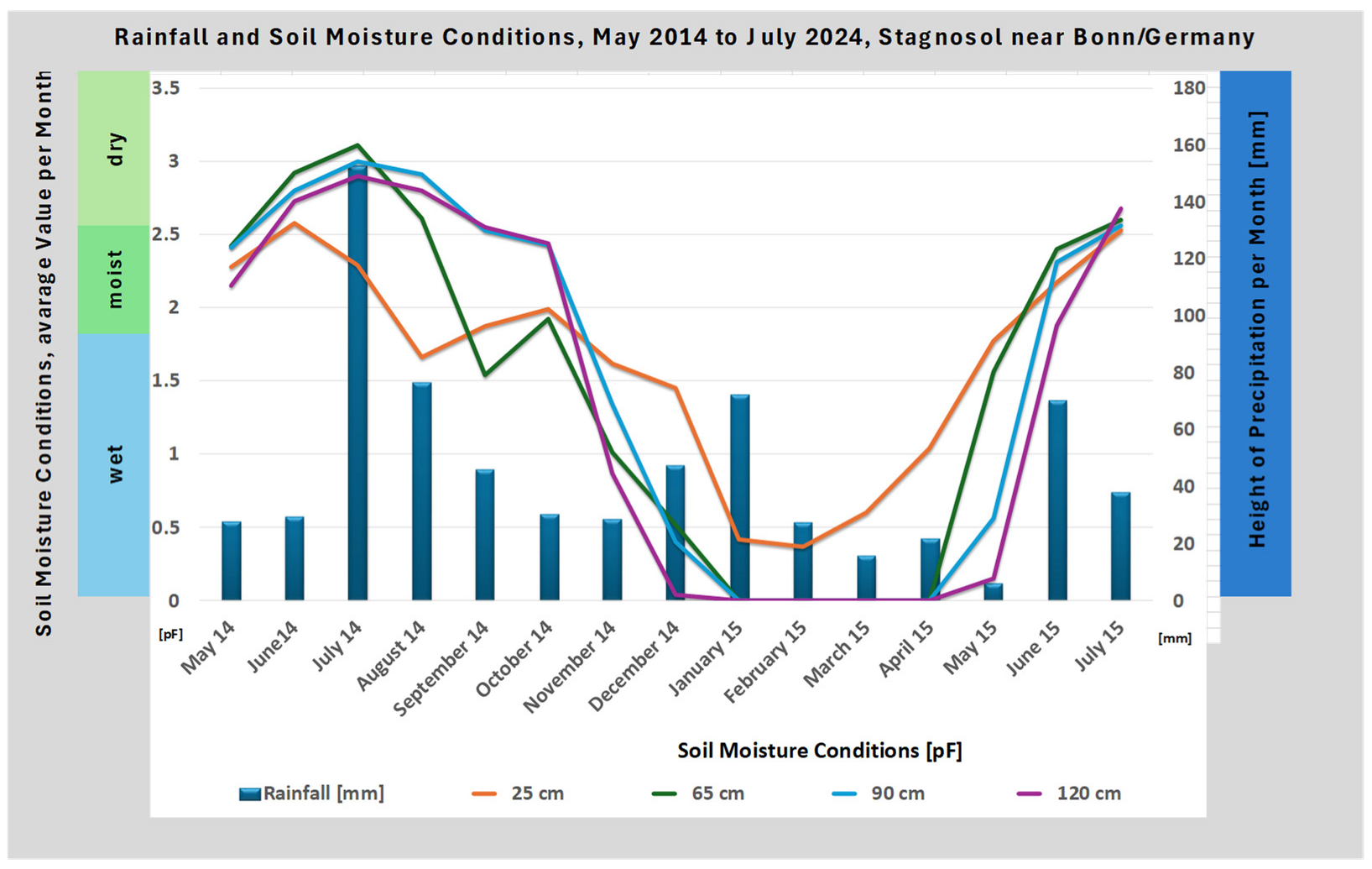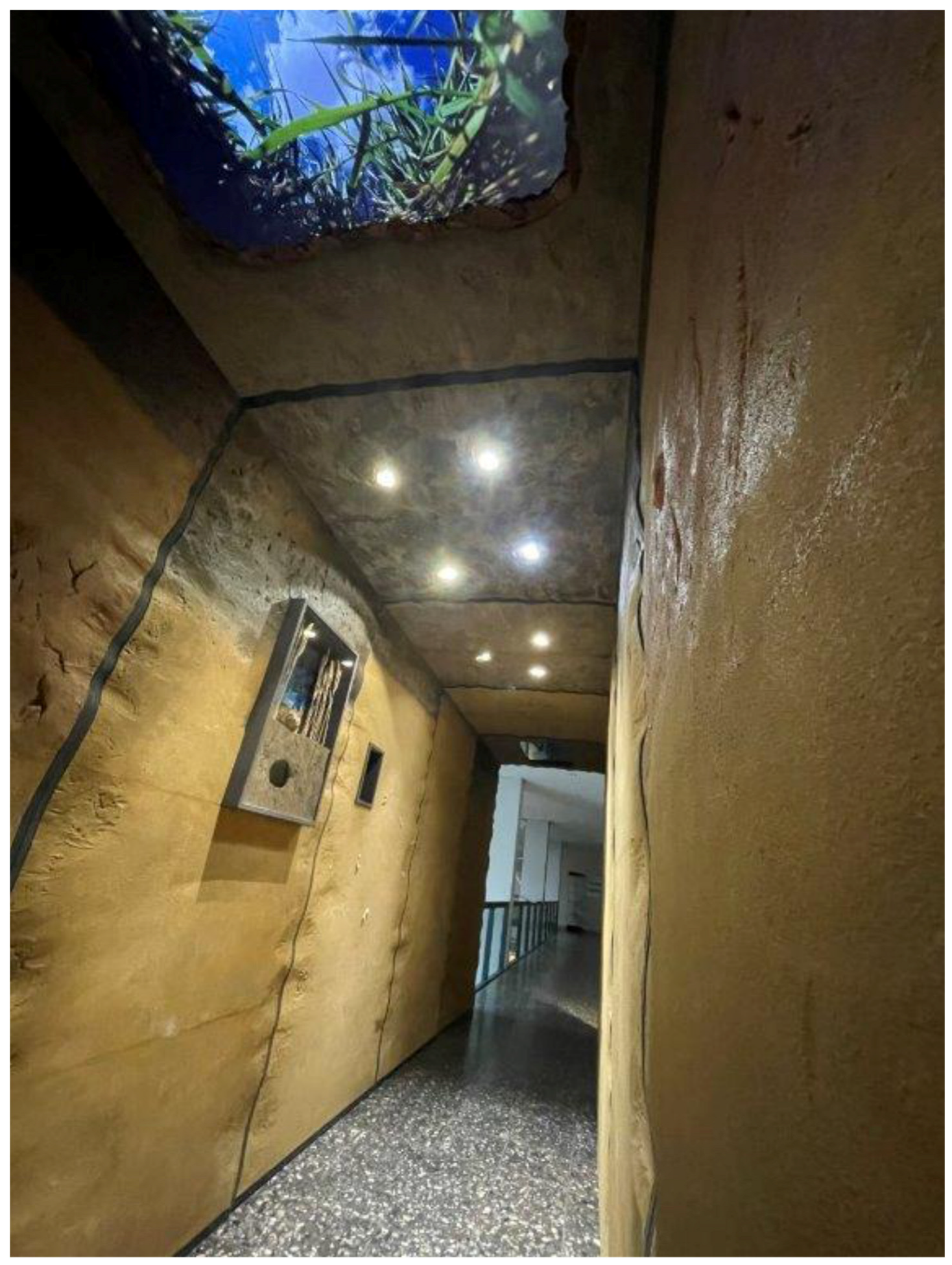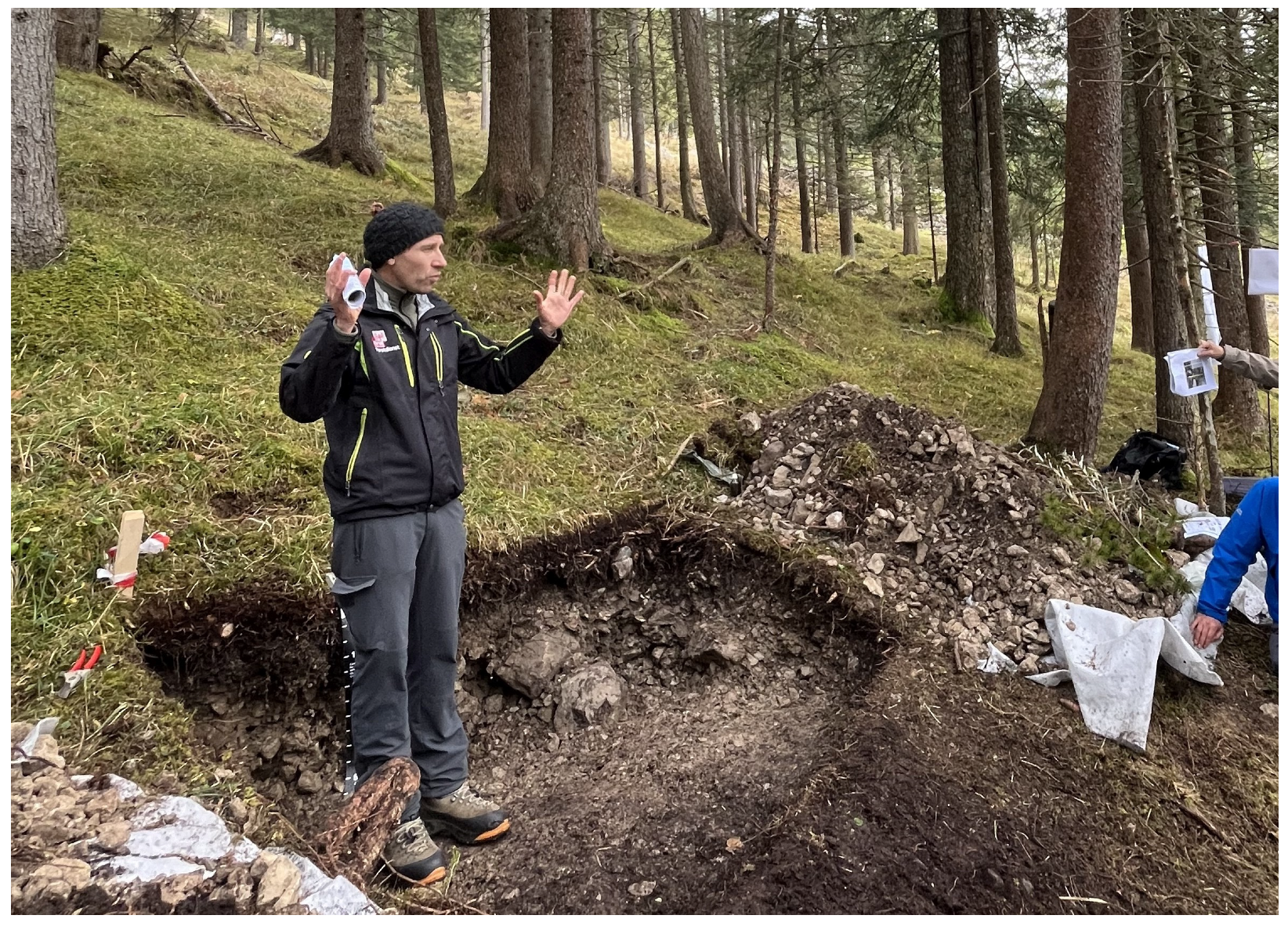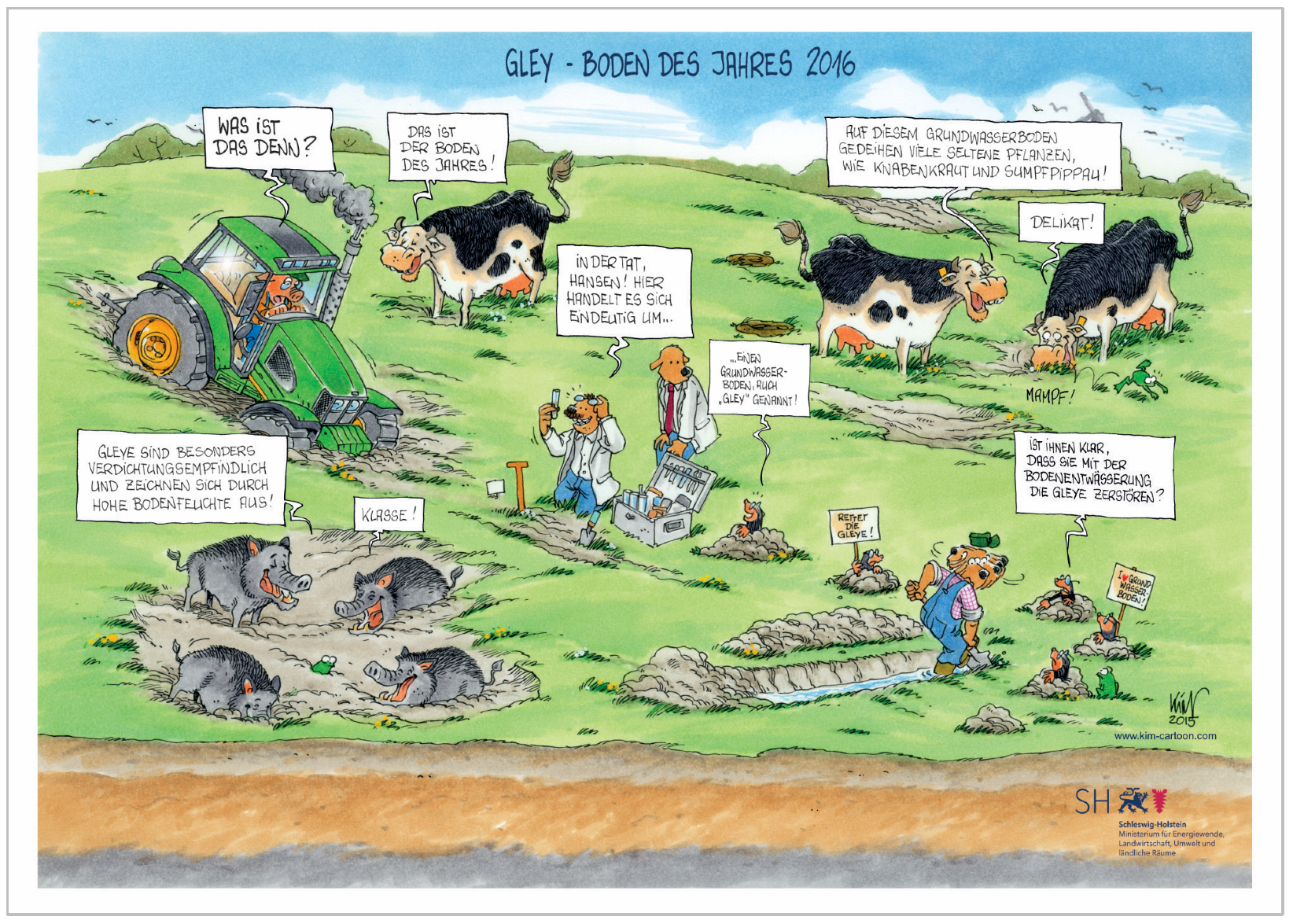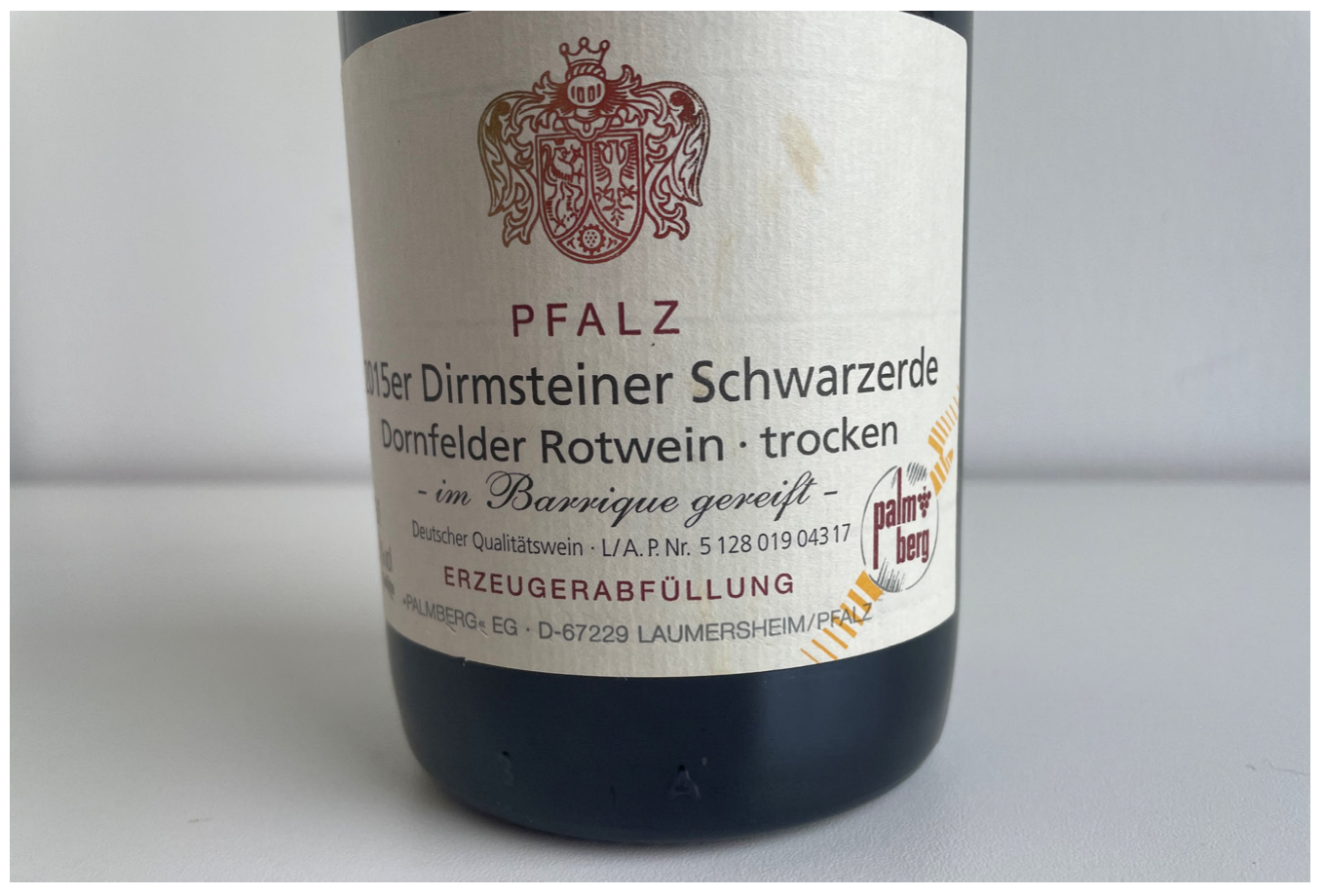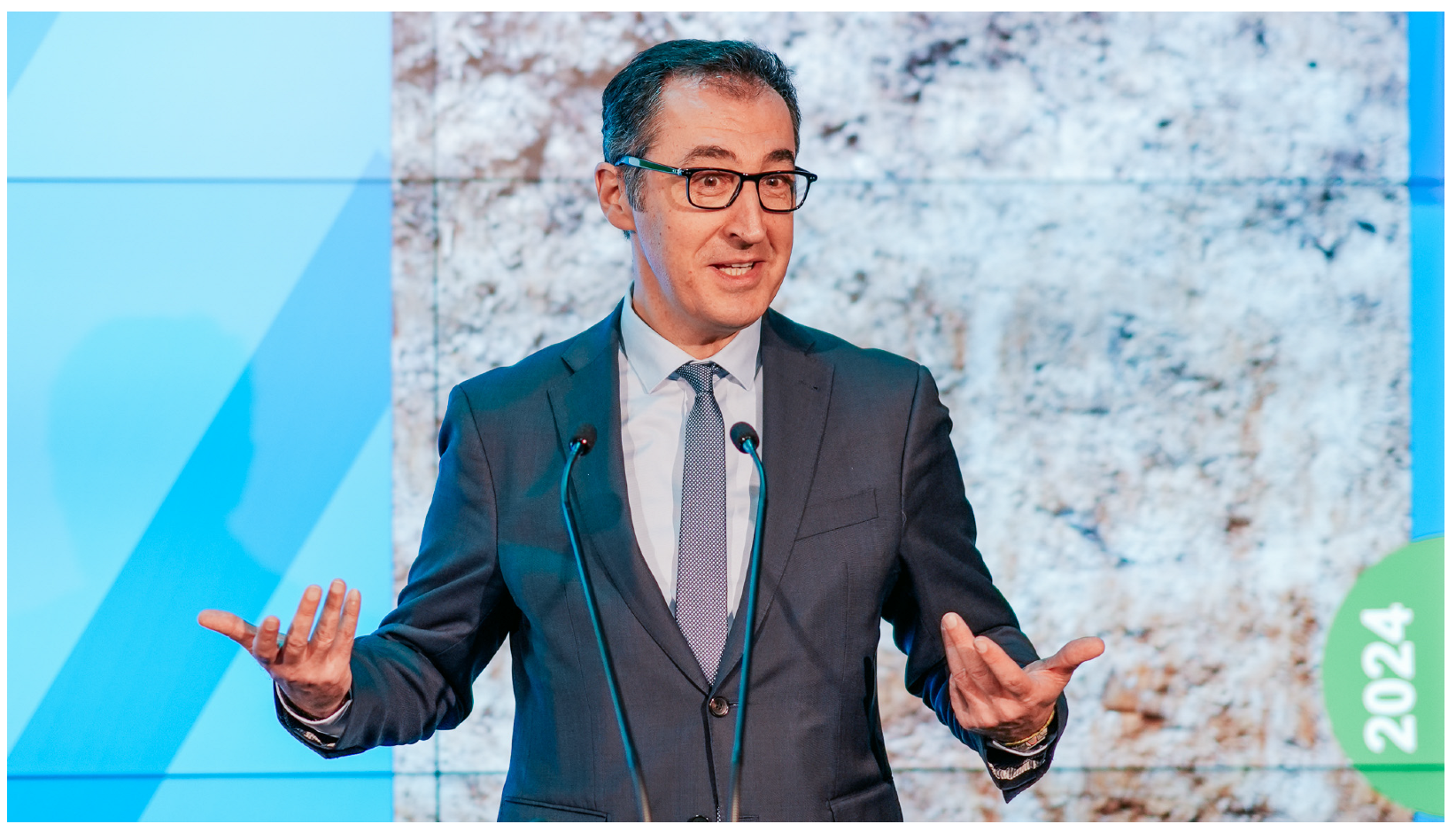3.1. The Origins of the Initiative
The foundation stone for the ‘Soil of the Year’ initiative was laid over two decades ago by soil scientist Prof. Dr. Monika Frielinghaus, then working at the Leibniz Centre for Agricultural Landscape Research (ZALF) in Müncheberg. The ZALF site is also home to the Senckenberg Institute of Entomology. In 1999, the institute’s then-director, Prof. Dr. Holger Heinrich Dathe, launched the ‘Insect of the Year’ campaign. Inspired by discussions between Prof. Frielinghaus and Prof. Dathe, the idea emerged to create a similar initiative to raise the public awareness of soils [
7]. Key collaborators in this effort initially included the two soil science organisations: the German Soil Science Society (DBG) and the German Soil Association (BVB), who established the ‘Soil of the Year’ Board in 2004. A few years later, the German Engineer Association for Management of Contaminated Soils and Land Recycling (ITVA) joined as a third partner.
The first ‘Soil of the Year’ was finally proclaimed in Osnabrück. On the occasion of World Soil Day in 2004, the inaugural ceremony was held under the patronage of the city’s mayor. The soil type Chernozem was declared the Soil of the Year for 2005 [
8]. The initiative was accompanied from the outset by the publication of a poster and a flyer, supplemented by scientific and popular science publications and press releases.
Since then, the ‘Soil of the Year’ has been presented annually on or around World Soil Day (5 December) in Berlin by the steering committee in collaboration with changing partners for the upcoming year. It is introduced as part of an accompanying public awareness campaign. Subsequently, the soil is promoted nationwide for one year through exhibitions, specialist lectures and excursions [
6].
While the Osnabrück Museum am Schölerberg and Osnabrück University of Applied Sciences were among the initiative’s most significant early partners, the German Environment Agency in Dessau has provided financial and organizational support for the campaign since 2008.
3.2. Objectives and Target Audience of the Initiative
The central objective of the ‘Soil of the Year’ campaign is to draw attention to the vital ecological roles soils play and to promote their sustainable use and protection. Soils serve as water reservoirs and filters, habitats for countless organisms and are the largest terrestrial carbon sink. However, they are increasingly threatened by erosion, sealing, compaction and pollution. Each year, the campaign focuses on a specific soil to illustrate these threats and the importance of preserving soil functions.
Beyond highlighting ecological relevance, the initiative seeks to embed soil conservation more firmly within societal discourse. By presenting a particular soil, the campaign illustrates the diversity of soils and their role in human life, aiming to inspire greater appreciation and responsibility towards this essential resource.
Modelled after initiatives like ‘Tree of the Year’ or ‘Insect of the Year’, the campaign conveys soil-related knowledge in an accessible, engaging way. It fosters understanding of how sustainable soil use underpins environmental stability and long-term human well-being.
The initiative targets a broad audience: from policymakers and educators to land users and the general public. It acts as a bridge between science and society, employing clear visuals and comprehensible messaging to encourage dialogue. The transparent work of the steering committee reinforces trust and supports long-term public engagement.
Key stakeholder groups can be divided into several categories, each playing a specific role in promoting soil awareness:
Educational institutions such as schools, kindergartens and universities are central to early and long-term knowledge transfer. Teachers act as multipliers and can introduce children and students to the ecological value of soils through lessons, field visits or school gardens.
Research institutes and museums serve as knowledge hubs. Through exhibitions, lectures and public engagement formats, they make scientific findings on soils accessible to wider audiences.
Planning and environmental professions, including landscape architects, environmental consultants and spatial planners, make land-use decisions that directly affect soil conservation. Their involvement is essential to integrate soil protection into practical planning processes.
Land users, such as farmers, foresters and gardeners, work with soils on a daily basis. Their practices have a direct impact on soil health and they benefit from practical knowledge on sustainable soil management.
Civil society actors, including journalists, conservationists and NGOs, function as important multipliers. They help to shape public opinion and bring soil topics into the media and political debates.
By addressing these diverse groups with tailored materials and messages, the campaign encourages broader engagement with soil issues and promotes long-term stewardship of this critical resource.
3.3. The Steering Committee and Its Partners
The steering committee of the ‘Soil of the Year’ campaign is currently a group of around 20 voluntary members with a specialist background. Its primary task is to nominate a specific soil each year. The core members of the committee include representatives from the German Soil Science Society (DBG [
9]), the German Soil Association (BVB [
10]) and the German Engineer Association for Management of Contaminated Soils and Land Recycling (ITVA) (
Figure 1).
A key element of the initiative is close collaboration with annually changing partners of the steering committee, who play a significant role in the success of the campaign. These partners are typically a federal state of Germany, represented by its agricultural or geoscientific state authorities, as well as soil science institutes. Frequently, the patronage for World Soil Day and the respective ‘Soil of the Year’ is assumed by the relevant minister and in some cases by the minister president of the partner federal state (see also
Section 3.5). These partners are approached by the steering committee 3 to 4 years in advance or may apply for a partnership themselves.
In collaboration with the steering committee, they select the soil to be highlighted each year and design a concept for the World Soil Day event, along with associated public relations activities. Through their financial support and committed efforts, the partners play a key role in ensuring the thorough documentation of the ‘Soil of the Year’ and the successful organisation of World Soil Day celebrations.
Additionally, experts in public relations and knowledge dissemination are elected to the committee to ensure the initiative achieves substantial public outreach.
The selection of a ‘Soil of the Year’ takes place in a multi-year planning process. With a lead time of several years, a soil is determined together with the annually changing partners in order to ensure sufficient time for the development of information materials and public relations work. This is accompanied by up to four meetings of the steering committee each year to coordinate progress and agree on details with the partners. These meetings take place both digitally and in person and are supplemented by numerous e-mail consultations.
A short, concise summary of the key information is compiled for each annual soil. Flyers and posters, which are available free of charge in printed form and digitally as PDF files for download, are used to publicise the project. The German Environment Agency is responsible for printing and dispatching the information material [
11]. In some years, posters and flyers are supplemented by brochures and exhibitions on the Soil of the Year. In addition, all relevant information is made available online on the project website (
https://boden-des-jahres.de, accessed on 6 June 2025) in order to reach a broad public. The website serves as a central source of information and is regularly updated with current content and background information on the respective ‘Soil of the Year’ [
8].
The steering committee of the ‘Soil of the Year’ campaign is represented by a spokesperson who acts as the central interface to the media. In the early years, Prof. Monika Frielinghaus took on this role. Since 2013, Dr. Gerhard Milbert has been the spokesperson for the steering committee. In addition to coordinating the content of the steering committee activities, he is also responsible for representing the campaign in public. Dr. Milbert has contributed to numerous scientific studies and has presented the ‘Soil of the Year’ across various platforms, including specialist events, excursions and media appearances. His media engagements range from interviews for print publications to contributions on ministry websites, as well as radio and podcast features. These efforts play a vital role in making the campaign’s objectives accessible to a wider audience. Through these activities, he enhances public awareness of the campaign and highlights the significance of soil protection within societal discourse.
3.5. The Previous Soils of the Year
The selection of Soils of the Year for the past 20 years represents the diversity of soils in Germany as well as their various functions, properties and significance for humans.
Table 1 below summarises the respective soils of the year. It is evident that in the first 5 years, there was initially a strong alignment with the guidelines of the German Soil Classification according to the Soil Mapping Instruction, and classical soil types were chosen.
With the nomination of the ‘Soil of the Year 2010’, the campaign deviated for the first time from the previous practice of selecting ‘classic’ soil types according to the German classification system. Instead, the choice of ‘Urban Soil’ introduced a more accessible type of soil use that was intended to promote public engagement, particularly in urban communities.
In addition to usage types, another category of soil naming was introduced into the selection of the ‘Soil of the Year’ which focuses on using simpler language to make the topic more accessible to the general public without prior knowledge of soil science. Examples include ‘Groundwater Soil’ (2016) or ‘Stagnant Water Soil’ (2015), which were chosen as the ‘Soil of the Year’ instead of their scientific names Gleysol and Stagnosol. Another, somewhat different example is the ‘Loess Soil’ (2021), where the focus was on the common parent material for soil formation that several soil types share.
Since 2010, the selection of the ‘Soil of the Year’ has alternated between classic soil types and more easily understood usage types or names of soil types, as illustrated in
Table 1. As the German soil names cannot always be translated directly, the classification according to the WRB was chosen in the table, which corresponds most closely to the respective Soil of the Year.
To systematically assess the thematic focus and relevance of the annually selected ‘Soils of the Year’, each soil was classified according to a set of predefined criteria (see
Table 2). These criteria reflect key ecosystem functions, public communication goals and current environmental challenges addressed by the respective annual campaign. The classification is based on expert assessment from the steering committee and highlights the main reasons for selection as communicated in campaign materials (see also
Section 3.4).
The criterion “Soil as a living space” refers to the soil’s role as a habitat for organisms and corresponds to the ecological function of providing living space.
“Specific land use” identifies soils that are closely associated with particular forms of land use, such as vineyard, garden or arable soils, thus connecting soil types to everyday human activities.
The criterion “Soil awareness” is marked for all soils, as each annual campaign contributes to raising general public awareness of soils and their importance.
In contrast, “Soil protection” is used selectively, for soils with high conversion pressure (e.g., arable soils with significant daily land loss) or soils with small areal extent that require special protection.
“Nature protection” applies to soils with a particularly high biodiversity potential, such as Rendzic Phaeosem, or to soils hosting highly specialised biotopes, such as intertidal flat soils.
The category “Soil vulnerability” reflects susceptibility to degradation due to factors such as erosion, compaction or drainage, which are frequently addressed in the communication of these soils.
The criterion “Pedogenetic soil stratification” is applied to soils that were selected primarily based on their taxonomic or classification-specific characteristics, such as Pelosol or future candidates like Andosol.
“Soil rarity” indicates soils with a very limited spatial extent, rare parent materials or specific geomorphological settings, which are often highlighted for their intrinsic protection value.
Finally, “Sensitivity to climate change” refers to soils particularly affected by climatic changes—such as Histosols (peat soils), Gleysols, Stagnosols or shallow, drought-prone soils like Rendzic Phaeosem. These soils often illustrate the direct impacts of changing precipitation regimes and temperature extremes on soil stability and function.
This matrix does not claim to be exhaustive or definitive, but rather offers an initial framework for categorising and comparing the thematic emphasis of the selected soils; it can serve as a basis for future refinement and discussion within the context of soil awareness and education.
3.6. High-Profile Activities for the ‘Soil of the Year’ Campaign
The ‘Soil of the Year’ campaign implements a variety of publicity measures to promote awareness of the importance and protection of soils in society. These activities are aimed at a wide audience and provide both general information and specific scientific content. The most important elements of public relations work can be summarised as follows:
A central element of the steering committee work is the World Soil Day celebration on 5 December, which takes place every year in Berlin (
Figure 2). The event is usually hosted by the federal state or institution that is the patron. This institution organises the event in cooperation with its Ministry of the Environment or Ministry of Agriculture or its specialist geoscientific authority. This festive presentation of the ‘Soil of the Year’ offers the opportunity to emphasise the role and function of the chosen soil type in a publicity-effective manner and to stress the social importance of soil protection. Around 150 to 200 guests, mainly with a soil science background, take part in a varied programme of lectures, activities and exhibitions. As potential multipliers for soil, they will help to publicise the current Soil of the Year. Media representatives are also invited.
A poster and a flyer on the respective soil of the year are produced annually to impart knowledge and raise public awareness. These materials are available both online on the campaign website (
https://boden-des-jahres.de/english (accessed on 6 June 2025)) and in printed form free of charge from the German Environment Agency. Around 15,000 flyers and 4000 posters are currently printed every year. They provide a clear and compact overview of the key properties, functions and protective measures as well as the regional distribution of the selected soil. In some cases, flyers and posters are supplemented by brochures and exhibition material.
Maintaining and regularly updating the website
https://boden-des-jahres.de (accessed on 6 June 2025) is a central element of public relations. The website serves as an information platform where current content on the campaign, detailed information on the respective soils and additional materials are provided. In addition, from 2019 on there was a dedicated social media presence on Twitter (later X). At the beginning of 2024, there was a switch to the social media platform Bluesky (@bodendesjahres.bsky.social), which also features current articles on the respective ‘Soil of the Year’. The respective ‘Soil of the Year’ is also presented on other websites of partner institutions and in soil science networks [
13].
Due to capacity constraints, the committee has so far not carried out regular and systematic evaluations of how the campaign’s reach has developed through the aforementioned media channels. However, a preliminary website analysis of boden-des-jahres.de indicates approximately 44,400 visits between 1 January 2025 and 24 May 2025, equating to an average of around 390 views per day. In addition to direct access, the main traffic sources include Google (2000 referrals), the German Environment Agency (1000) and the Nature and Biodiversity Conservation Union NABU (450). Since 2023, public visibility has also been enhanced through the use of press distribution services by the committee and its partners, with increasing integration into the websites of state governments, environmental agencies and geological services.
The campaign is accompanied by numerous publications aimed at both the scientific community and the general public. Every year, articles about the Soil of the Year are published in relevant specialised journals. In addition, popular science articles are published to make the topic accessible to a wider audience.
Various press releases are issued to increase the reach of the campaign. Spokespersons for the steering committee are available for interviews in print media, radio programs and podcasts in order to communicate the importance of soil protection. This media work helps to anchor the topic in the public debate. Above all, distribution via social media channels has proven its worth in recent years when it comes to reaching young people.
Since the introduction of the ‘Soil of the Year’ initiative, a special stamp has been issued annually to highlight the respective soil of the year (
Figure 3). This project was initiated by the soil scientist Prof. Dr. Hans-Peter Blume [
14]. Initially, the stamps were printed in Austria and Liechtenstein; since 2017, production has been handled by Deutsche Post. Approximately 1500 stamps are produced each year. They are widely used as promotional materials in business correspondence by soil scientists, companies, organisations and offices.
In addition to the central campaign, regional activities are implemented. For example, the participating federal states often publish their own brochures or website articles on the specific soils. Additionally, accompanying activities, such as a call for participation in the ‘urban soil’ theme, are initiated to involve local stakeholders and citizens.
The annual partners involved in the initiative frequently produce lacquer profiles of the ‘Soil of the Year’ and develop materials for exhibitions. For instance, during the International Year of Soils (2015), an exhibition on waterlogged soils was created and presented to several thousand visitors at 24 different locations over the course of the year (
Figure 4). At the site in a natural forest near Bonn that served as the reference profile for this soil of that year, a permanently measuring station was installed to record precipitation, soil moisture, redox potential and pH value (
Figure 5). The measurement results were published and commented as weekly averages on the Soil of the Year website, along with photographs of the soil and surrounding forest. To this day, the measuring station provides a large amount of data every day, which serve as the basis for controlling soil moisture in a nature reserve. It is a characteristic feature of the “Soil of the Year” initiative that each designated soil is represented by a reference profile, supported by comprehensive analytical data.
Special attention was drawn to a walkable soil tunnel, created by the Federal Institute for Geosciences and Natural Resources (BGR) to mark the Soil of the Year 2021 (Loess Soil). In combination with acoustic elements and information panels, the three-dimensional soil tunnel was made accessible to a wide audience as part of a travelling exhibition (
Figure 6). Additionally, it is possible to visit the tunnel online [
15].
Excursions and workshops that focus specifically on the selected soil of the year are a practical addition to public relations work. These events make it possible to experience the special features and functions of soils directly on site and impart practical knowledge to participants (
Figure 7).
Artistically innovative formats such as painting workshops, science and poetry slams, and multimedia interactive exhibitions represent effective new approaches for reaching previously underrepresented target groups. For instance, the Ministry of the Environment in Schleswig-Holstein commissioned a comic on the topic of groundwater soils (Gleysols) in late 2016, which was met with a highly positive response (
Figure 8). Similarly, the ‘Soil of the Year 2020’ celebrations featured a poetry slam dedicated to the Intertidal Flat Soil, attracting enthusiastic participation from numerous young people.
The ‘Soil of the Year’ 2014 (Vineyard Soil) campaign vividly demonstrated how sensory experiences can enhance communication of soil-related themes. By linking vineyard soils to wine production, the initiative highlighted how soil properties directly influence taste—a concept actively embraced by many winegrowers in their marketing strategies (
Figure 9). Wine tasting events, in which the sensory qualities of wines were connected to specific soil types (terroir), established an immediate and relatable connection between soil and everyday life. A similarly effective approach was realised through the 2021 ‘Soil-Bread’ campaign, which used a specially developed loaf to symbolise the significance of Loess Soil. This initiative involved bakeries nationwide and brought soil awareness into people’s daily routines through taste and symbolism [
16].
3.7. Impact and Outreach of the Campaign
3.7.1. Development of Reach and Public Acceptance
Since its inception, the ‘Soil of the Year’ campaign has undergone continuous development. While its initial public impact was relatively limited and concentrated around the respective annual events, the initiative has gained substantial reach over time. Improved public relations efforts, targeted cooperation and increasing media involvement have significantly contributed to broader public visibility and engagement. Systematic evaluations have not yet been carried out in this context, or relevant data are lacking. To date, the campaign has focused primarily on communicating pedological knowledge in a targeted and accessible manner. As all activities are undertaken on a voluntary basis, statistical analysis was not initially prioritised. Nonetheless, a clear increase in public interest, and thus in the campaign’s overall reach, has been observed over the years. In parallel, the committee has continuously refined its approach, drawing on the latest research findings in the field of soil communication.
A research project conducted by the German Environment Agency examined which soil awareness activities contribute to greater public recognition of soils and to soil-conscious behaviour in politics and society [
17]. The study was based on an analysis of completed and ongoing campaigns and initiatives aimed at fostering soil awareness, including exhibitions, municipal activities, leisure events and social media formats. The ‘Soil of the Year’ campaign was among the initiatives reviewed. As a result of the project’s recommendations, the annual events have for many years been professionally moderated, held at central venues, complemented by cultural contributions and supported by accompanying information stands and exhibitions.
On the national level, several initiatives have exemplified the campaign’s capacity to reach broader audiences. In 2010, the ‘Urban Soil’ campaign was launched alongside a nationwide call for participation. Municipalities, schools, research institutes and civil society organisations were invited to engage with the topic of urban soils. In Berlin, this led to the formation of a dedicated working group involving representatives from the Berlin Senate, educational institutions, conservation centres and engineering firms [
18]. Another notable example is the 2017 collaboration with allotment garden associations. These efforts aimed to highlight the recreational and ecological value of urban gardens, inform gardeners about sustainable practices in composting and plant protection, and emphasise their contribution to biodiversity conservation.
Internationally, the campaign has also gained traction. A key milestone was the collaboration with Austria in 2008, when the Soil of the Year (Cambisol) was jointly presented at the EUROSOIL conference in Vienna—marking the first transnational recognition of the initiative [
19]. The 2015 UN International Year of Soils further strengthened global momentum, offering a framework for bundling activities and enhancing the visibility of soil-related issues across borders. More recently, the 2025 Soil of the Year (Rendzina) highlighted the importance of international cooperation through a German–Danish partnership. With reference to soil profiles on the islands of Møn (Denmark) and Rügen (Germany), the campaign underscored the shared responsibility for soil protection and demonstrated the relevance of cross-border scientific exchange.
Together, these national and international developments illustrate how the campaign has evolved into a platform that not only raises public interest in soils but also fosters dialogue and collaboration across societal and geographical boundaries.
3.7.2. Comparable Actions in Other Countries
Germany was among the first countries to establish a ‘Soil of the Year’ campaign, launching the initiative in 2005. This early engagement has served as a reference point for similar activities in other countries that have since adopted the concept. In some instances, even the same soil types were selected, highlighting both shared ecological concerns and the international relevance of certain soils (e.g., the Cambisol 2008 in Austria and Germany [
19]). While each national campaign sets its own priorities, the German initiative has played a pioneering role in promoting the idea of using an annually selected soil to raise public awareness and foster dialogue on soil protection.
Similar initiatives to the German ‘Soil of the Year’ campaign now exist in various countries, with which Germany cooperates in partnership. For example, at the end of 2007, the Austrian Soil Science Society joined the supporting body of the ‘Soil of the Year’ campaign [
20]. In Switzerland, the ‘Soil of the Year’ campaign has been organised by the Swiss Soil Science Society since 2010. Similar to the German initiative, the focus here is also on promoting public awareness of the diversity of soil types and their importance. Every year, a specific soil type is selected on World Soil Day, 5 December. The aim of this campaign is to emphasise the ecological and social relevance of soils and to sensitise a broad target group to the need to protect this resource. So far, Switzerland is the only country apart from Germany to maintain its own homepage for the campaign [
21].
Comparable activities also exist in The Netherlands [
22], Poland [
23] and recently in Denmark. These also pursue the goal of promoting soil protection and raising public awareness of the central importance of soils. Each initiative sets its own national priorities and adapts to the specific ecological and social circumstances of its countries.
The activities in the other countries share the overarching objectives of the German initiative and emphasise the importance of soil protection through scientifically sound educational work, public events and cooperation with partners from research, politics and society. However, only a limited number of countries have so far established comparable national campaigns. The concept of designating a ‘Soil of the Year’ remains relatively rare at the international level. To date, no systematic analyses or comparative evaluations exist that document the scope, implementation or impact of such initiatives. This highlights the need for further research and international exchange in order to identify successful strategies and promote broader adoption of awareness-raising campaigns for soil protection.
To date, Germany remains the only country to implement a comprehensive ‘Soil of the Year’ campaign that includes an official launch event, the publication of dedicated posters and brochures and coordinated nationwide outreach activities. While other countries have adopted similar concepts, they have not yet developed the same level of continuity, visibility or institutional support. In 2024, the ‘World Soil of the Year’ was awarded for the first time by the International Union of Soil Sciences (IUSS) [
24]. Mirroring the inception of a similar campaign in Germany, the Chernozem of the Balti Steppe, Moldova, was selected as the inaugural honouree for this international initiative. The announcement took place during the celebratory event ‘100 Years of the International Union of Soil Sciences’ held in May 2024 in Florence. This marked a significant milestone in recognising the importance of soils globally [
25]. To guide the selection and detailed documentation of future World Soils of the Year, the newly established IUSS World Soil of the Year Working Group has introduced specific guidelines [
26].
3.7.3. Cooperation and Knowledge Transfer as the Key to Success
The ‘Soil of the Year’ initiative stands out for its ability to connect various stakeholders from science, politics and society, creating a platform for the exchange of knowledge. It acts as a bridge between these areas by making soil-related topics accessible to a wide audience and emphasising their relevance to everyday life. The addressees of the ‘Soil of the Year’ campaign are explicitly not experts in soil science, but people in society. The language used is important here, especially the avoidance of technical language and terms [
27]. The topic must therefore be prepared and communicated for media-effective and target group-orientated communication—in the sense of science communication.
Especially in times when soil science topics are often perceived as overly specialised and complicated, this type of communication is of critical importance [
28]. The initiative provides researchers with the opportunity to present their findings in an understandable form to a broader public, thereby significantly promoting knowledge transfer. The goal of science communication is to stimulate interest and foster informed engagement among decision-makers and diverse public audiences regarding the importance of soils, thereby encouraging active involvement with the topic [
29]. The aim is to provide them with a fundamental level of knowledge that enables them to recognise connections, contextualise information and pose specific questions.
The initiative’s reach is evident not only in societal but also in scientific and political dimensions. The increased attention to soil-related topics has led to a rise in publications focusing on the respective ‘Soil of the Year’. These publications not only deliver scientific insights but also offer practical solutions, which are particularly beneficial for farmers, forestry professionals and municipalities.
By linking soil protection with key challenges such as sustainable land use and climate protection, the initiative gains an additional political dimension.
The annual presentation of the new ‘Soil of the Year’ on World Soil Day, usually under the patronage of a federal state, further enhances this political relevance. This is also emphasised by its alignment with international political frameworks, in particular the United Nations Sustainable Development Goals (SDGs) [
30]. Adopted in 2015, the SDGs define ambitious targets for sustainable development, among which SDG 15 “Life on Land” directly addresses the protection and sustainable use of terrestrial ecosystems, combating desertification and achieving land degradation neutrality by 2030. The ‘Soil of the Year’ campaign contributes to these objectives by promoting awareness of soil degradation and mobilising societal engagement. It highlights the fact that soil protection is not only a scientific concern, but also a political and ethical imperative. Moreover, soil protection is closely linked to other key SDGs [
31]: SDG 2 “Zero Hunger” acknowledges the role of healthy soils in ensuring food security; SDG 6 “Clean Water and Sanitation” recognises soils as vital filters and regulators in the water cycle; and SDG 13 “Climate Action” reflects the function of soils as carbon sinks and their relevance in climate change mitigation.
The campaign ‘Soil of the Year’ thus supports an integrated understanding of sustainability and the central role soils play across multiple environmental and development goals. It raises awareness among political decision-makers about the importance of soil protection and emphasises the responsibility that comes with the sustainable use of this vital resource (
Figure 10). In this way, the ‘Soil of the Year’ initiative has not only profoundly influenced scientific discourse but also shaped political and societal engagement with soil-related issues.
3.7.4. Public Impact Factors
The public impact of the ‘Soil of the Year’ campaign is closely linked to the characteristics of the selected soil type. Experience has shown that two key factors are decisive in determining the level of public engagement: didactic quality and aesthetic suitability [
32].
Didactic quality refers to how easily a soil’s properties and functions can be understood and communicated. Soils with a clearly traceable formation process and a tangible connection to everyday life offer significant advantages. They allow for engaging narratives and create meaningful links to human experience. When a soil type illustrates broader themes—such as climate change, land use or biodiversity—it can serve as an effective vehicle for environmental education and awareness-raising.
Aesthetic suitability, on the other hand, relates to the visual and sensory appeal of the soil. Soils with distinct horizon boundaries, contrasting colours or textured structures are more likely to attract attention and interest (e.g., the Podzol,
Figure 11a). Their visual characteristics not only support intuitive understanding but also lend themselves well to exhibitions and media formats.
When both didactic clarity and aesthetic appeal are present, a soil is far more likely to resonate with the public. Conversely, when either aspect is lacking, communication becomes more challenging. This was evident in the case of the Soil of the Year 2006 –Fahlerde (Albeluvisol/Retisol)—which, due to its visually inconspicuous profile and complex genesis, struggled to generate widespread public interest (
Figure 11b).
By contrast, certain soil types have demonstrated a particularly successful balance of both qualities. Urban Soil and Garden Soil, for instance, are closely linked to familiar environments and daily practices and thus offer high didactic accessibility. At the same time, they provide sufficient visual and thematic diversity to support public engagement. The Vineyard Soil of 2014 is another outstanding example. It combined visually striking features with a strong cultural and sensory dimension through its connection to wine production, allowing the concept of terroir to serve as an intuitive link between soil and taste. These examples underscore how a well-chosen soil can effectively bridge scientific content and public understanding.
To date, only the didactic suitability of the selected soils has been evaluated [
32]. Aesthetic aspects have always played a role in the decision-making process, yet the actual impact of each annual campaign has not been subject to formal analysis. In the
Supplementary Materials (
Table S1), a tabular overview is provided, outlining the didactic potential of each ‘Soil of the Year’ from 2005 to 2025 (after [
32], supplemented). This compilation offers initial insights into the communicative strengths of individual soils, but further research is needed to assess their broader educational and outreach effectiveness.
3.7.5. Optimisation of Materials and Media Presence
To enhance recognition, the campaign’s supporting materials have been continuously professionalised over the years. Since 2014, posters and flyers have been designed in a unified corporate design, strengthening the visual identity of the initiative (
Figure 12).
This effort has been complemented by increased presence in print media, radio broadcasts and podcasts, which help bring the topic of soil closer to a broad audience.
The use of high-quality visuals and clearly structured key messages has significantly improved the accessibility and recognisability of the campaign. Materials are deliberately designed to appeal to both lay audiences and professionals by combining simplified language with engaging imagery. Printed brochures and posters are regularly distributed at schools, exhibitions, and environmental events, where they support education and public outreach.
Some regional partners have begun adapting central materials for local use by adding regional data or links to local projects. An illustrative example of regional adaptation took place in 2014, when the federal state of Rhineland-Palatinate assumed patronage for the ‘Vineyard Soil’ as Soil of the Year. In this context, a region-specific brochure was developed about the vineyard soils [
33] and additionally published in English. This adaptation of central campaign materials illustrates how the integration of local information and context-specific messaging can enhance both the relevance of the content and its resonance with targeted audiences. This decentralised application enhances relevance and fosters a stronger connection with local communities.
Looking ahead, further diversification of media formats, such as interactive elements or multilingual content, could help make soil-related communication more engaging and inclusive.
3.8. Challenges and Criticism
Communicating the importance of soils to a broad audience remains a fundamental challenge of the ‘Soil of the Year’ campaign. Unlike animals or plants, soils lack clear contours and emotional appeal. Their diversity is mostly hidden beneath the surface, their ecological functions are complex, and the effects of degradation often remain invisible for long periods. As a result, soil is frequently perceived as an inexhaustible resource rather than as a vulnerable component of the environment. This makes it difficult to evoke a sense of urgency or personal relevance among the general public.
Within the soil science community, the campaign has occasionally been met with criticism, particularly regarding the simplification of complex soil concepts. For example, the designation of usage types such as “Arable Soil” or “Forest Soil” has been questioned for potentially obscuring scientific nuance. However, such formats are not intended to replace detailed classifications but to provide accessible entry points for public engagement. The campaign does not aim to convey the full complexity of soil science within a single year. Rather, it seeks to raise interest, initiate dialogue and create space for further learning. In this sense, the Soil of the Year acts as a public ambassador for soil-related knowledge. Each year, the balance between scientific accuracy and public accessibility is carefully discussed within the steering committee and jointly coordinated with the annual partners. There is no fixed formula for this process; instead, the communication strategy is tailored individually to the specific characteristics and outreach potential of the selected soil.
One of the most demanding tasks is to address diverse target groups with tailored yet inclusive communication strategies. As discussed in previous sections, broad public appeal requires the use of simple language, visual materials and relatable examples, while professionals need in-depth and differentiated content. Educational institutions benefit from teaching materials that help integrate soils into curricula. Land users, such as farmers or foresters, require practice-oriented information. Journalists and educators can act as multipliers—provided the content is media-friendly and well structured. In 2024, for instance, a multi-day training seminar was held specifically for forest and nature educators to raise their awareness of the role of soils in ecosystem dynamics. Another example of such tailored communication is the brochure
“Boden schützen leicht gemacht—Mit kleinen Schritten Großes bewirken” (Protecting Soil Made Easy—Small Steps with Big Impact”), published in 2019 [
34]. It was developed in cooperation with partners involved in the ‘Soil of the Year’ campaign and provides practical, easy-to-implement suggestions for soil-friendly behaviour in everyday life, gardening and construction. The brochure illustrates how scientific knowledge can be translated into accessible and actionable messages—thus supporting individual responsibility for soil protection across various societal groups. Balancing outreach and specificity requires careful planning and coordination. While broad visibility ensures societal awareness, target-group-specific strategies foster deeper understanding and sustained engagement. Social media platforms such as the Bluesky account @bodendesjahres.bsky.social and emerging tools like artificial intelligence offer new opportunities for tailored communication and interactive participation. These technologies can help disseminate content effectively, create new spaces for dialogue with both the public and experts, and generate personalised material aligned with specific interests. AI tools can also be employed to visualise complex soil-related data in an intuitive and accessible manner. Furthermore, interactive applications such as quizzes or virtual reality experiences can foster participation, create immersive learning environments, and support long-term engagement, particularly among younger audiences. The use of AI in science communication, however, requires transparent quality control and clear ethical guidelines. Automatically generated content must be critically reviewed to ensure accuracy, contextual relevance and scientific integrity [
35]. The steering committee is therefore encouraged to approach the integration of AI-supported tools with both openness and caution, aligning technological innovation with the campaign’s educational mission.
In parallel, the campaign would benefit from the introduction of regular evaluation mechanisms. Feedback from participants, website and social media analytics, as well as media monitoring, can help assess the effectiveness of outreach efforts. There is clear potential to accompany the campaign’s future development through more consistent and detailed monitoring.
Another central challenge lies in ensuring long-term continuity. The high level of voluntary commitment by members of the steering committee has been vital to the campaign’s success. Nevertheless, despite financial support from the German Environment Agency and the annually changing partners, the ongoing development of the initiative requires stable funding, creative resources and professional expertise—particularly in areas such as accessible language, science communication and public relations. Recruiting specialists and securing long-term partnerships remains a critical task.
Ultimately, the campaign seeks to embed soil protection more deeply in societal consciousness and political agendas, supporting measures that extend beyond the scope of a yearly initiative. Sustainable soil management cannot be achieved through isolated efforts; it requires continuous public outreach, targeted education and scientifically grounded communication. Concern for soils must become as self-evident as the commitment to clean air and safe drinking water.

